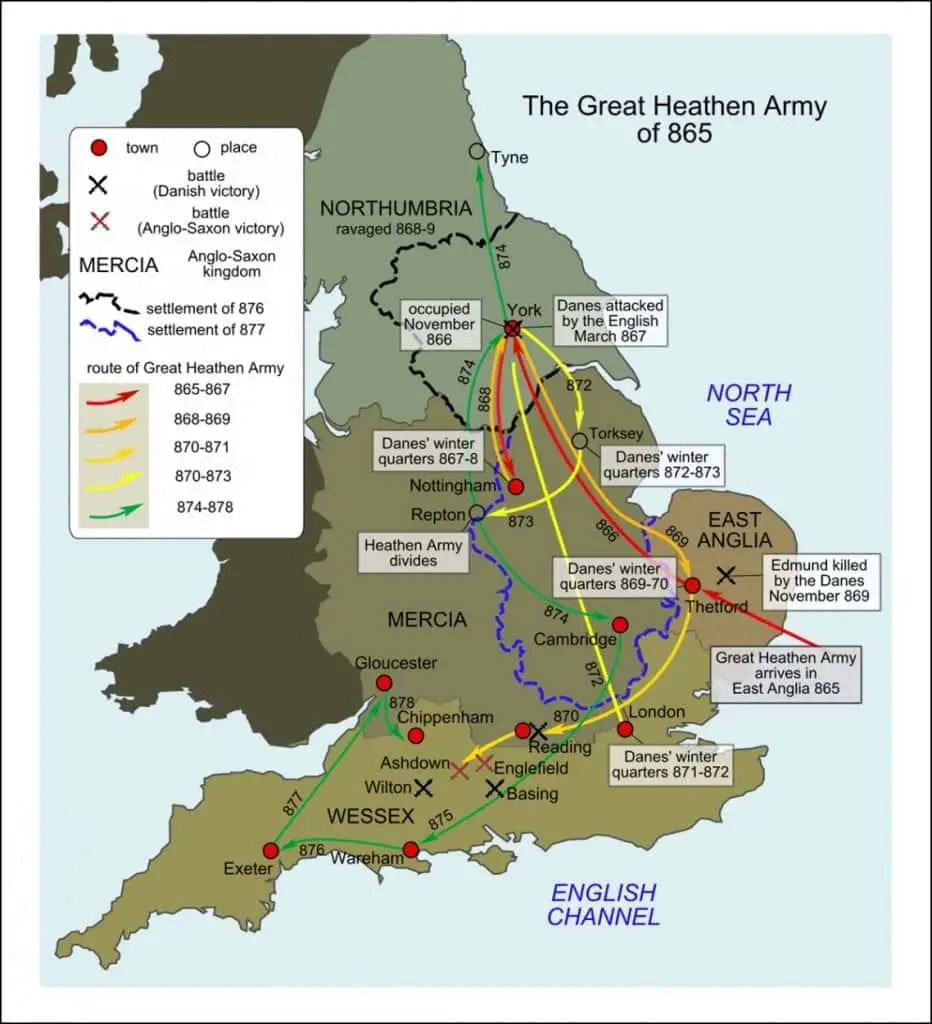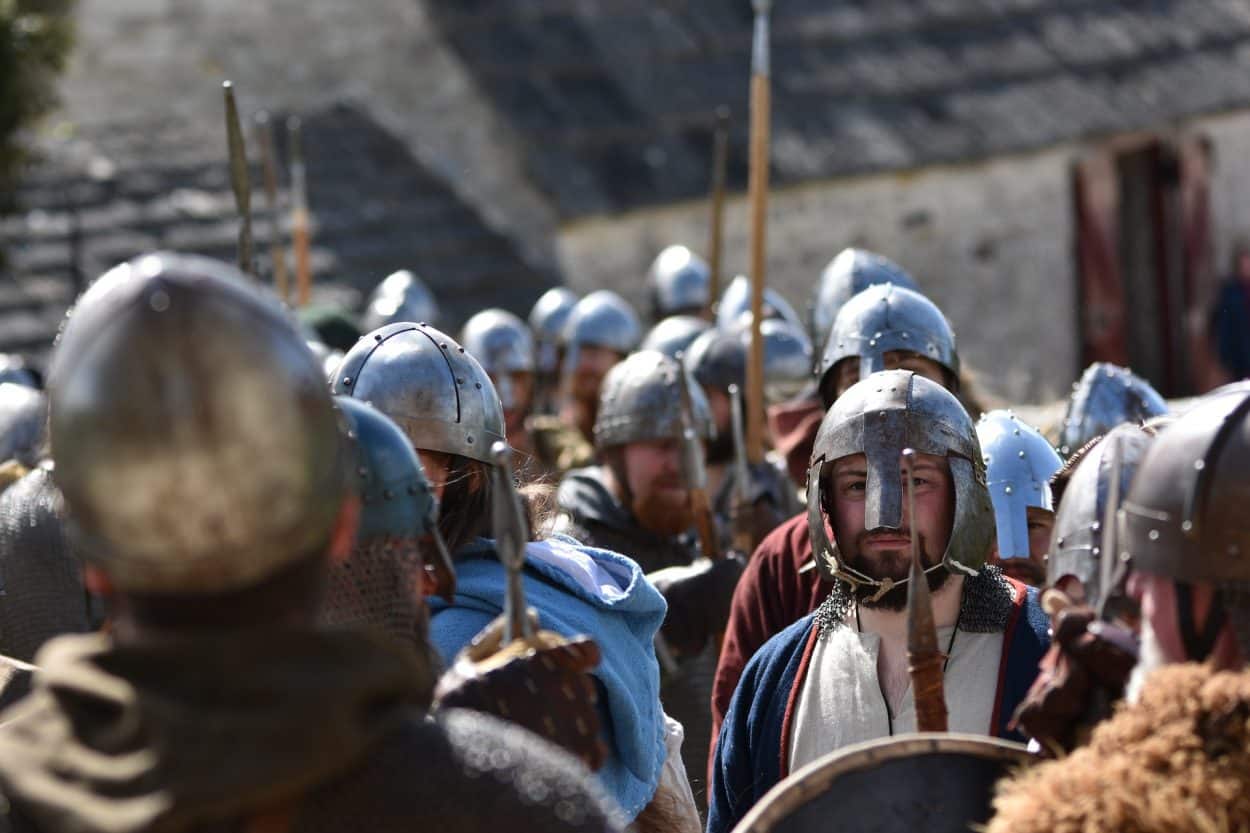The Great Heathen Army was a coalition of Viking warriors that invaded England in AD 865, which according to lore was in response to the death of the legendary figure Ragnar Lodbrok, at the hands of King Ælla of Northumberland.
The tales of Ragnar and his sons in Norse poetry, the Anglo-Saxon Chronicles, and the Icelandic sagas depict Ragnar leading an expedition of only two knarrs to ravage and burn England. His forces were overwhelmed by Ælla, and Ragnar is captured and thrown into a snake pit to die.
His sons Inwaer (Ivar the Boneless), Halfdan Ragnarsson, and Hubba (Ubbe) lead a Viking army that captures Ælla and supposedly performs the blood eagle (a ritualistic method of execution in which the ribs are severed from the spine with a sharp tool, and the lungs are pulled through the opening to create a pair of “wings”) in revenge.
Scholars debate the validity of the literature and historical provenance connecting Ragnar to the events that led to the invasion of England. Contemporary text is often regarded as fictitious, with the image of Ragnar being an amalgam of historical figures and literary invention.
The true reason for the invasion is obscured although most likely for monetary gain, but in AD 865 a sizeable force estimated to be no more than 1,000 men (although some historians believe the army numbered in the thousands) landed in East Anglia and wintered until next season.
The Great Heathen Army then marched north and captured Northumbria and its capital, York, defeating both the recently deposed King Osberht of Northumbria and the usurper Ælla of Northumbria. A puppet ruler was placed on the Northumbrian throne called Ecgberht I, who simply served to tax the population to fund further Viking campaigns.
With a northern powerbase established, the Great Heathen Army marched to the Kingdom of Mercia and wintered near present-day Nottingham. After several skirmishes between the Vikings and a combined Mercian/Wessex army, the Mercian’s agreed to pay a danegeld (a tax raised to pay tribute to prevent the land from being ravaged) and the Vikings returned north.
In AD 869 the Great Heathen Army marched back to the kingdom of East Anglia and wintered in Thetford where they killed King Edward, who would later be known as Edmund the Martyr. The Anglo-Saxon Chronicle describes the event: ‘here the army rode across Mercia into East Anglia, and took winter-quarters at Thetford; and that winter King Edmund fought against them, and the Danish took the victory, and killed the king and conquered all that land’.

In AD 871, reinforcements referred to as the ‘Great Summer Army’ arrived from Scandinavia and the Viking’s attention was now placed on the Kingdom of Wessex. After several small battles, the Great Heathen Army met the armies of Wessex led by King Ethelred and his younger brother (the future King Alfred the Great) at the Battle of Ashdown.
The Great Heathen Army was routed and gave flight, with many Viking warriors cut down in the Wessex advance. Three months later, Æthelred died and was succeeded by Alfred, who paid a danegeld to allow him to buy time and prepare for the next Viking incursion.
In AD 874, the Great Heathen Army drove King Burgred of Mercia into exile and finally conquered the Mercian Kingdom leaving Wessex to stand alone.
According to Alfred the Great’s biographer Asser, the Vikings then split into two bands, one led by Halfdan which raided north into Scotland, and another led by Guthrum, Oscetel and Anwend which campaigned against Wessex.
Over the next several years, Wessex continued to resist the Viking threat and eventually defeated the Great Heathen Army at the Battle of Edington. This culminated in the signing of the Treaty of Wedmore (no document survives), an accord referenced in Asser’s biography of Alfred in which Guthrum submits to be baptised and withdraw the remnants of the Great Heathen Army from Wessex lands.
A formal treaty was later agreed called the ‘Treaty of Alfred and Guthrum’ which sets out the boundaries between Alfred and Guthrum’s territories as well as agreements on peaceful trade, and the weregild value of its people.
Although several Viking armies emerged to threaten Wessex, Alfred defended his kingdom and the armies would eventually disperse to East Anglia and Northumbria, establishing the demarcated territories between Wessex and the Viking Danelaw.
Header Image Credit : Public Domain





